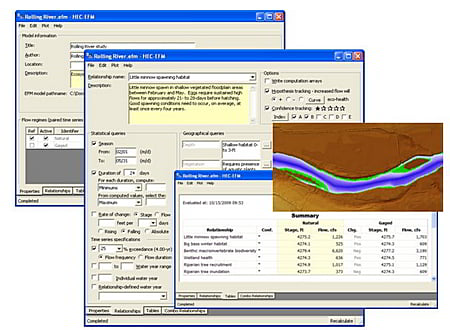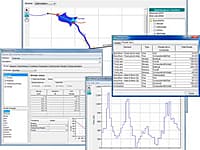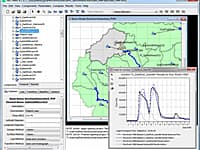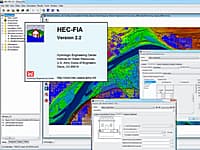The Ecosystem Functions Model (HEC-EFM) is designed to help study teams determine ecosystem responses to changes in the flow regime of a river or connected wetland.
HEC-EFM analyses involve:
1) statistical analyses of relationships between hydrology and ecology,
2) hydraulic modeling, and
3) use of Geographic Information Systems (GIS) to display results and other relevant spatial data.
Through this process, study teams will be able to visualize and define existing ecologic conditions, highlight promising restoration sites, and assess and rank alternatives according to predicted changes in different aspects of the ecosystem.
HEC-EFM has many strengths, most notably
1) it is capable of testing ecological change for any number of relationships and flow regimes,
2) it links ecology with established hydrologic, hydraulic, and GIS tools, and
3) it can be applied quickly, inexpensively, and can incorporate expert knowledge.
HEC-EFM is also a generic software tool, applicable to a wide range of riverine and wetland ecosystems.
* HEC-EFM download link provides gnu general public license version of the software.
HEC-ResPRM is a reservoir system operations optimization software package developed to assist planners, operators, and managers with reservoir operation planning and decision-making.
Statistical Analyses Of Hydrologic Data
Statistical Software Package (HEC-SSP) developed by the Hydrologic Engineering Center. This software allows you to perform statistical analyses of hydrologic data.
The Hydrologic Modeling System (HEC-HMS) is designed to simulate the complete hydrologic processes of dendritic watershed systems.
The HEC-FIA Flood Impact Analysis software package analyzes the consequences from a flood event.
HEC-RAS is designed to perform one-dimensional hydraulic calculations for a full network of natural and constructed channels.
Submit a review about HEC-EFM software with your social media profile







No comments yet. Be the first to comment.